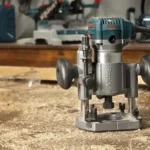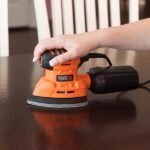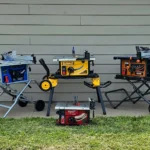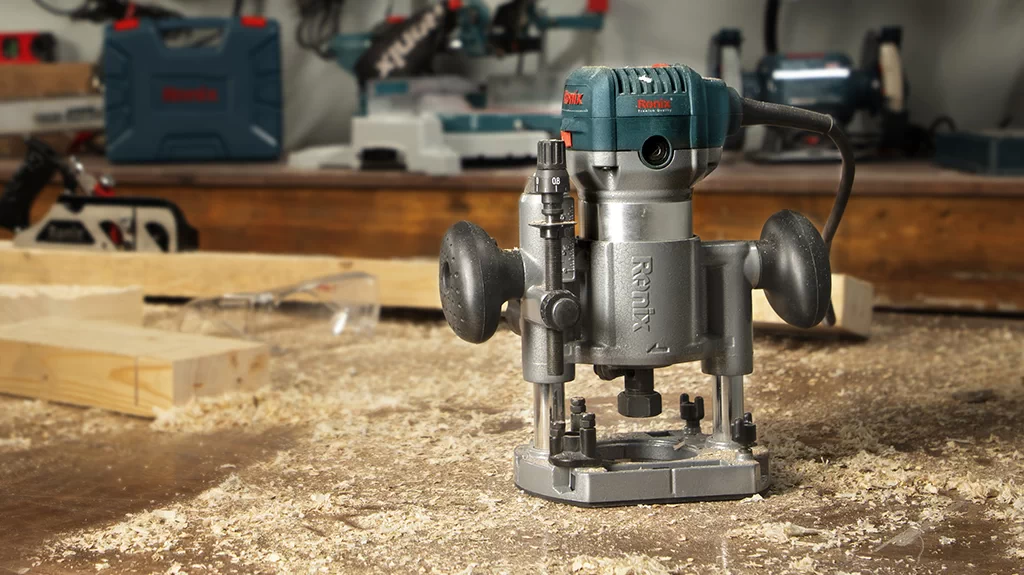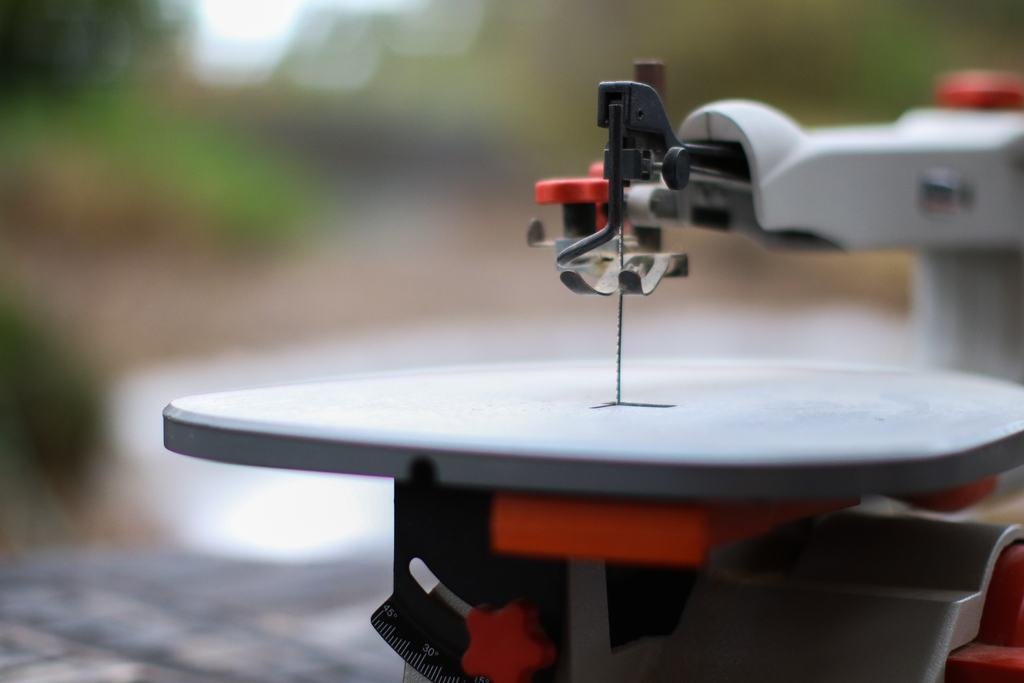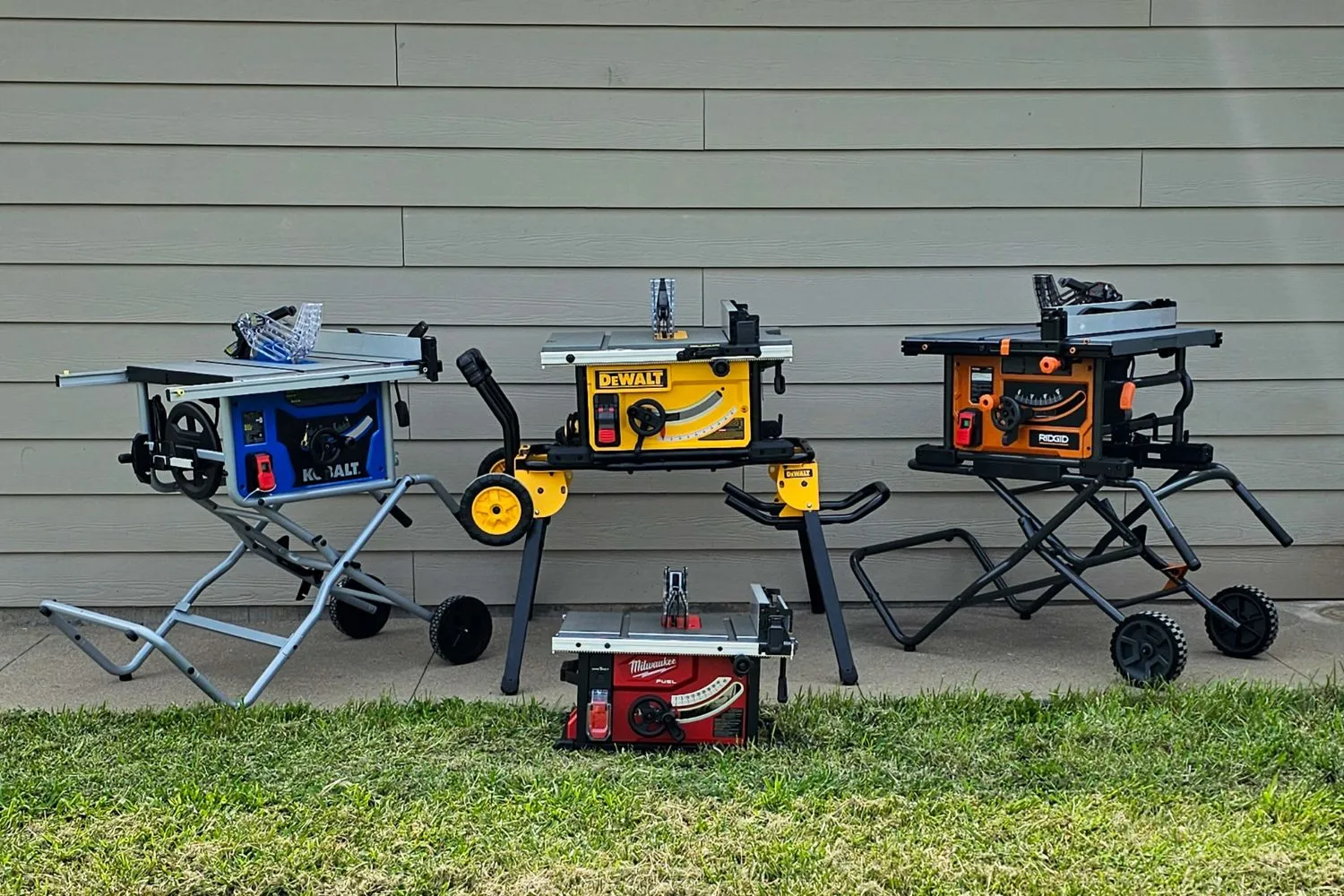Sanding cabinets is an indispensable step in both refinishing old cabinetry and preparing new pieces for finishing. The process of sanding helps to achieve a smooth, even surface, which is crucial for ensuring that paints, stains, and varnishes adhere properly and look their best.
Whether you’re giving a facelift to a worn-out cabinet or working on a new project, using the best sander for cabinets can make a significant difference in the outcome.
The benefits of sanding are manifold. Firstly, it removes any existing finish, scratches, and imperfections, providing a clean slate for the new finish.
Secondly, it helps in leveling the surface, which is especially important for cabinets that may have been exposed to moisture or heavy use over the years.
Lastly, proper sanding allows the wood grain to be more receptive to stains and sealants, ensuring a more durable and aesthetically pleasing result.
There are various types of finishes that can be applied to sanded cabinets, ranging from paints and stains to clear varnishes and polyurethane coatings. The choice of finish often depends on the desired look and the type of wood being used.
For example, a stain can highlight the natural beauty of the wood grain, while a coat of paint can offer a more modern and uniform appearance.
When it comes to the tools of the trade, several types of sanders are available, each designed for specific tasks and outcomes. Orbital sanders are excellent for achieving a fine finish and are easy to control, making them ideal for detailed work on cabinet surfaces.
Belt sanders, on the other hand, are powerful and efficient, perfect for removing old finish quickly or leveling uneven surfaces. Random orbital sanders combine the best features of both, offering power and a smooth finish with minimal risk of swirl marks.
In the sections that follow, we will delve deeper into these different types of sanders, evaluating their strengths and weaknesses, and providing recommendations to help you choose the best sander for cabinets tailored to your specific needs.
Table of Contents
Types of Sanders: An Overview
When embarking on a cabinet refinishing project, selecting the right sander is crucial to achieving a smooth and professional finish.
There are several types of sanders that can be used for cabinets, each offering unique features and benefits. Understanding these variations will help you determine the best sander for cabinets tailored to your specific needs.
Orbital sanders, also known as finishing sanders, are ideal for fine sanding and finishing work. They use circular sanding motions and are perfect for smoothing out surfaces and preparing them for painting or staining. Their lightweight design and ease of use make them a popular choice for DIY enthusiasts.
However, they may not be as effective for heavy-duty material removal, which limits their use to lighter sanding tasks.
Detail sanders, often referred to as corner or mouse sanders, are designed for precision work. Their triangular-shaped pads can reach tight spaces and intricate areas, making them indispensable for detailed cabinet work. While they excel in sanding corners and edges, their small size limits their effectiveness for larger surfaces, making them best suited for touch-ups and finishing details.
Belt sanders are powerful tools that are best suited for heavy-duty sanding tasks. They use a continuous loop of sandpaper that moves in a linear motion, making them highly efficient at removing material quickly.
Due to their power and speed, belt sanders are ideal for stripping old finishes and leveling large, flat surfaces. However, they can be challenging to control and may not be suitable for delicate or detailed work.
Random orbital sanders combine the features of both orbital and belt sanders. They use a random orbit action, which minimizes swirl marks and provides a smooth finish. This versatility makes them one of the best sanders for cabinets, as they can handle both rough and fine sanding tasks.
Their ability to deliver uniform results on a variety of surfaces makes random orbital sanders a favorite among professionals and hobbyists alike.
Each type of sander has its own strengths and weaknesses, and the choice ultimately depends on the specific requirements of your cabinet project.
By understanding the unique features and applications of orbital, detail, belt, and random orbital sanders, you can select the best sander for cabinets, ensuring a flawless and efficient refinishing process.
Key Features to Look for in a Cabinet Sander
When selecting the best sander for cabinets, it is crucial to consider several key features that significantly impact both performance and user experience. One of the primary factors is motor power.
A more powerful motor ensures efficient sanding, especially when dealing with hardwood cabinets or multiple layers of paint and varnish. Typically, a motor with at least 3 to 5 amps is recommended for cabinet sanding, providing the necessary force to achieve a smooth finish.
Speed settings are another essential feature to examine. Variable speed settings allow users to adjust the sander’s speed according to the type of material and the level of finish required.
For instance, lower speeds are better suited for delicate surfaces, while higher speeds can handle more robust materials and extensive sanding tasks. A sander with adjustable speed settings offers greater versatility and control, making it a valuable tool for any cabinet project.
Dust collection capabilities are paramount for maintaining a clean work environment and ensuring the longevity of the sander. A sander with an efficient dust collection system not only minimizes the mess but also protects the motor from dust accumulation, thereby extending its lifespan.
Look for models with built-in dust bags or those compatible with external vacuum systems, as these can significantly reduce airborne particles and improve air quality in your workspace.
Ease of use is another critical aspect to consider. Sanders that are lightweight and have intuitive controls are generally easier to handle, reducing user fatigue during extended use.
Moreover, features like easy-to-change sandpaper and clear instruction manuals can streamline the sanding process, making it more efficient and less time-consuming.
Ergonomic design plays a vital role in the overall user experience. Sanders with comfortable grips and well-balanced bodies reduce strain on the hands and wrists, allowing for prolonged use without discomfort.
Additionally, a design that minimizes vibration can further enhance comfort and control, leading to better results and a more pleasant sanding experience.
By carefully evaluating these features—motor power, speed settings, dust collection capabilities, ease of use, and ergonomic design—you can select the best sander for cabinets that meets your specific needs, ensuring both high performance and user satisfaction.
Top 5 Sanders for Cabinets: Reviews and Comparisons
When it comes to finding the best sander for cabinets, the market is awash with options that can make the decision-making process daunting.
Here, we provide comprehensive reviews of the top five sanders currently available, focusing on their key specifications, pros and cons, and performance in cabinet sanding.
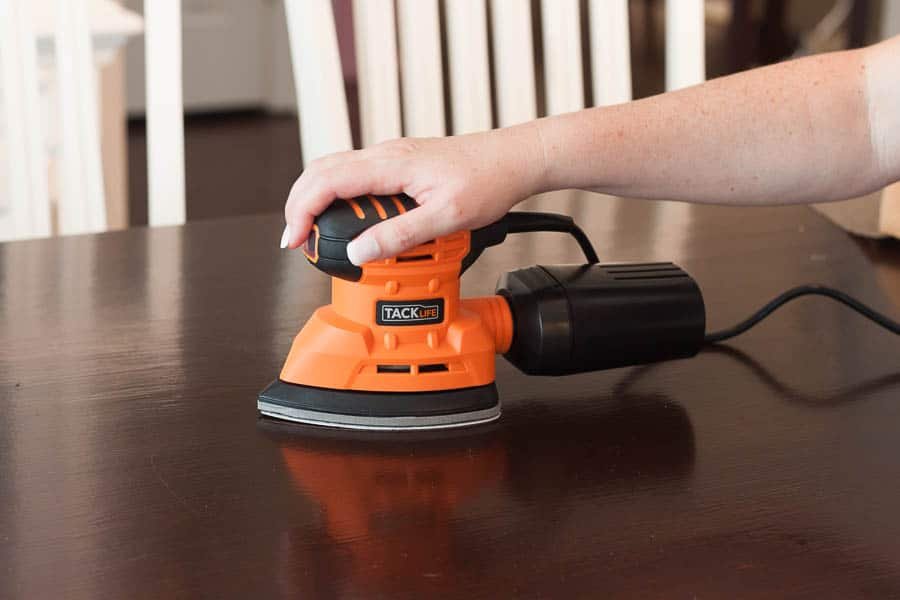
1. DEWALT DWE6423K Variable Speed Random Orbit Sander
This sander stands out with its 3.0-amp motor capable of delivering between 8,000 to 12,000 OPM (oscillations per minute). Its variable speed feature allows for precise control, making it ideal for different stages of cabinet sanding. The ergonomic design and low vibration levels enhance comfort and reduce fatigue during extended use.
Pros:
- Variable speed control
- High build quality
- Comfortable and ergonomic design
- Dust collection system
Cons:
- Relatively heavy
- Higher price point
2. Bosch ROS20VSC Palm Sander
The Bosch ROS20VSC features a 2.5-amp motor and variable speed control ranging from 7,500 to 12,000 OPM. Known for its efficient microfilter dust collection system, this sander is great for keeping the workspace clean. Its compact and lightweight design allows for easy maneuverability, making it suitable for detailed cabinet work.
Pros:
- Excellent dust collection
- Variable speed
- Lightweight and compact
- Affordable
Cons:
- May struggle with heavy-duty sanding
- Short power cord
3. Makita BO5041 Random Orbit Sander
Equipped with a 3.0-amp motor and delivering 4,000 to 12,000 OPM, the Makita BO5041 is designed for both power and precision. Its adjustable front handle and large two-finger trigger switch make it user-friendly. This sander excels in cabinetry due to its versatility and high performance.
Pros:
- High power and variable speed
- Adjustable handle for better control
- Efficient dust collection
- Durable construction
Cons:
- Can be a bit noisy
- Heavier than some competitors
4. BLACK+DECKER BDERO100 Random Orbit Sander
This budget-friendly option features a 2.0-amp motor and a fixed speed of 12,000 OPM. While lacking variable speed control, its simplicity and affordability make it a great choice for hobbyists and occasional users. The compact design ensures easy handling, perfect for smaller cabinet projects.
Pros:
- Very affordable
- Compact and easy to handle
- Decent dust collection
Cons:
- No variable speed control
- Less powerful motor
5. Festool ETS 125 REQ Random Orbital Sander
Known for its premium quality, the Festool ETS 125 REQ features a 2.6-amp motor and delivers speeds of 6,000 to 12,000 OPM. Its exceptional dust extraction system and superior build quality make it a favorite among professionals. This sander offers unparalleled smoothness and precision, making it one of the best sanders for cabinets.
Pros:
- Exceptional build quality
- Highly efficient dust extraction
- Variable speed control
- Lightweight and ergonomic
Cons:
- Very expensive
- May be overkill for casual users
In comparing these models, it’s clear that each sander has its unique strengths and potential drawbacks. Buyers need to consider their specific needs, budget, and the scale of their cabinetry projects to determine the best sander for cabinets in their particular situation.
How to Properly Use a Sander on Cabinets
When working on cabinetry, using the best sander for cabinets can significantly enhance your results. Proper usage ensures a smooth, even finish that highlights the wood’s natural beauty. To start, preparation is key. Begin by cleaning the cabinets thoroughly to remove any dirt, grease, or residue.
This step is crucial as it prevents debris from interfering with the sanding process. For cabinets with existing finishes, use a chemical stripper or a scraper to remove old paint or varnish before sanding.
Selecting the right sandpaper grit is vital for achieving the desired finish. Start with a coarser grit, such as 80 or 100, to remove rough surfaces and imperfections. Progressively move to finer grits, like 150 or 220, to smooth the surface and prepare it for staining or painting.
The choice of sandpaper grit can vary depending on the wood type and the condition of the cabinets, so adjust accordingly to achieve the best results.
Safety precautions are essential when using a sander. Always wear protective gear, including safety goggles, dust masks, and hearing protection. Ensure the work area is well-ventilated to minimize the inhalation of dust particles.
Secure the cabinets or doors to prevent movement during sanding, and always keep fingers and other body parts away from the sander’s moving parts.
Effective sanding techniques contribute to a professional finish. Maintain even pressure on the sander to avoid creating uneven surfaces. Move the sander in a consistent, circular, or back-and-forth motion, following the grain of the wood.
This approach prevents scratches and ensures a uniform appearance. Avoid applying excessive pressure, as this can damage the wood and reduce the lifespan of your sandpaper.
Using the best sander for cabinets can make a significant difference in your woodworking projects. By following these guidelines, you can achieve a smooth, flawless finish that enhances the overall aesthetic of your cabinets.
Maintaining Your Sander for Longevity
Ensuring the longevity and optimal performance of your sander is essential, especially when dealing with intricate tasks such as cabinet sanding. Proper maintenance not only extends the life of your tool but also guarantees consistently high-quality results.
To keep your sander in the best possible condition, it is crucial to adopt a routine that includes cleaning, inspecting for wear and tear, and appropriate storage.
Firstly, regular cleaning of your sander is imperative. Dust and debris can accumulate quickly, particularly when used on wood surfaces. After each use, take the time to clean the sander by wiping it down with a soft cloth.
Pay special attention to the air vents, which can become clogged and reduce the tool’s efficiency. Using compressed air can help remove any stubborn particles that a cloth may miss.
Additionally, it is important to inspect your sander for any worn or damaged parts. The sanding pads or belts can wear out over time, impacting the quality of your work. Replace these components as needed to ensure that your sander performs optimally.
Likewise, check for any loose screws or bolts and tighten them to prevent operational issues. Bearings and brushes should also be examined periodically, as they are critical to the motor’s function. Replacing worn bearings and brushes can prevent more significant, costly repairs down the line.
Proper storage practices are equally crucial for maintaining your sander. Store the sander in a clean, dry environment to avoid exposure to moisture, which can lead to rust and other damage. Using a protective case or cover can help shield your sander from dust and accidental damage when not in use.
Finally, being able to troubleshoot common issues can save you time and extend the life of your sander. If your sander is overheating, it could be due to clogged air vents or overuse.
Addressing these issues promptly can prevent long-term damage. If you notice a significant drop in performance, it may be a sign that internal components need attention or replacement.
By following these maintenance tips, you can ensure that your sander remains the best sander for cabinets for years to come, providing reliable and efficient performance whenever you need it.
Safety Tips for Sanding Cabinets
When working with power tools, especially when seeking the best sander for cabinets, safety should always be your top priority.
Whether you’re a seasoned professional or a DIY enthusiast, adhering to essential safety practices ensures not only your well-being but also the quality of your project. The following guidelines are designed to help you navigate the sanding process safely and effectively.
Firstly, always wear appropriate protective gear. This includes safety goggles to shield your eyes from dust and debris, ear protection to guard against the noise generated by the sander, and a dust mask to prevent inhalation of harmful particles. Gloves are also advisable to protect your hands from potential abrasions and the vibration of the sander.
Proper ventilation is crucial when sanding cabinets. Working in a well-ventilated area or using a dust extraction system can significantly reduce the accumulation of dust, which is not only a respiratory hazard but can also impair visibility and lead to accidents. If you’re working indoors, consider using fans or opening windows to enhance airflow.
Handling the sander correctly is another critical aspect of safety. Before starting, ensure that the sander is in good working condition and that the sanding pad or paper is securely attached. Always hold the sander with both hands for better control, and maintain a firm, but not overly tight, grip.
Begin sanding at a low speed to get a feel for the tool and gradually increase the speed as needed. Avoid applying excessive pressure, as this can lead to uneven sanding and increase the risk of the sander slipping or causing damage.
Taking regular breaks is essential to prevent fatigue. Operating a sander for extended periods can lead to decreased focus and an increased likelihood of accidents. Short, frequent breaks allow you to rest, reassess your progress, and maintain a high level of precision and safety throughout your project.
By following these safety tips, you can ensure a safer and more efficient sanding experience, ultimately leading to a smoother and more professional finish on your cabinets. Prioritizing safety not only protects you but also helps in achieving the best results with your chosen sander for cabinets.
Conclusion and Final Recommendations
In conclusion, selecting the best sander for cabinets is crucial for achieving a professional finish in your woodworking projects. Throughout this comprehensive guide, we have explored various types of sanders, including orbital, belt, and detail sanders, each offering unique advantages for cabinet work.
We have also highlighted key features such as dust collection systems, variable speed settings, and ergonomic designs that enhance the efficiency and comfort of your sanding tasks.
It is essential to assess your specific needs and project requirements when choosing a sander. For instance, if you are working on large, flat surfaces, an orbital sander might be the most suitable option due to its ability to cover extensive areas quickly.
On the other hand, for intricate and detailed work, a detail sander would be more appropriate, providing precision and control in tight spaces.
Moreover, considering the material of your cabinets is also vital. Different finishes and woods may require different sanding techniques and tools.
Therefore, understanding the characteristics of your material will help you select a sander that can deliver the best results without damaging the surface.
As we have discussed, some sanders come with additional features like dust collection bags or integrated vacuum systems, which can significantly reduce cleanup time and maintain a healthier work environment. Investing in a sander with these features can enhance your overall sanding experience and efficiency.
Ultimately, the best sander for cabinets will depend on a combination of factors, including the specific tasks at hand, the material of your cabinets, and your personal preferences. We recommend thoroughly researching and possibly testing different models to find the one that best suits your needs.
By considering these insights and recommendations, you will be better equipped to make an informed decision and achieve exceptional results in your cabinet sanding projects.
